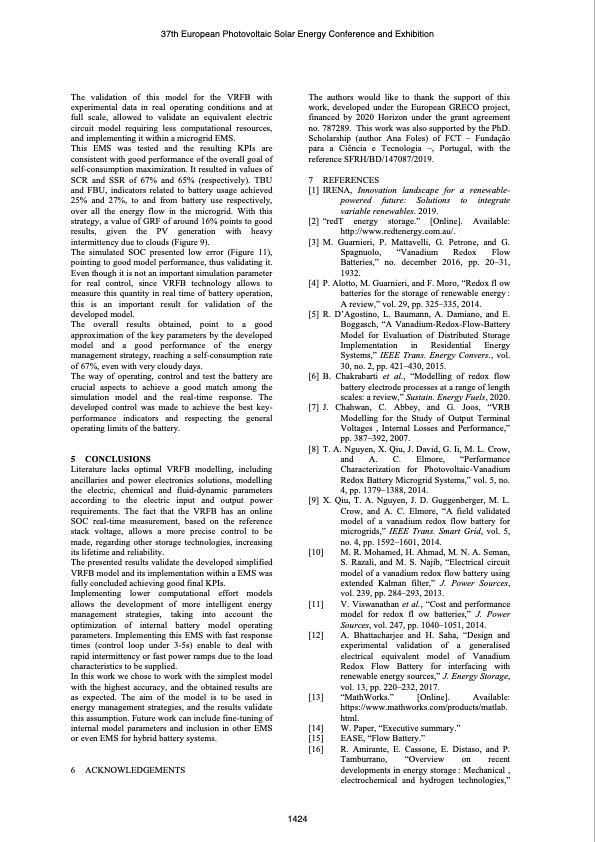
PDF Publication Title:
Text from PDF Page: 007
37th European Photovoltaic Solar Energy Conference and Exhibition The validation of this model for the VRFB with experimental data in real operating conditions and at full scale, allowed to validate an equivalent electric circuit model requiring less computational resources, and implementing it within a microgrid EMS. This EMS was tested and the resulting KPIs are consistent with good performance of the overall goal of self-consumption maximization. It resulted in values of SCR and SSR of 67% and 65% (respectively). TBU and FBU, indicators related to battery usage achieved 25% and 27%, to and from battery use respectively, over all the energy flow in the microgrid. With this strategy, a value of GRF of around 16% points to good results, given the PV generation with heavy intermittency due to clouds (Figure 9). The simulated SOC presented low error (Figure 11), pointing to good model performance, thus validating it. Even though it is not an important simulation parameter for real control, since VRFB technology allows to measure this quantity in real time of battery operation, this is an important result for validation of the developed model. The overall results obtained, point to a good approximation of the key parameters by the developed model and a good performance of the energy management strategy, reaching a self-consumption rate of 67%, even with very cloudy days. The way of operating, control and test the battery are crucial aspects to achieve a good match among the simulation model and the real-time response. The developed control was made to achieve the best key- performance indicators and respecting the general operating limits of the battery. 5 CONCLUSIONS Literature lacks optimal VRFB modelling, including ancillaries and power electronics solutions, modelling the electric, chemical and fluid-dynamic parameters according to the electric input and output power requirements. The fact that the VRFB has an online SOC real-time measurement, based on the reference stack voltage, allows a more precise control to be made, regarding other storage technologies, increasing its lifetime and reliability. The presented results validate the developed simplified VRFB model and its implementation within a EMS was fully concluded achieving good final KPIs. Implementing lower computational effort models allows the development of more intelligent energy management strategies, taking into account the optimization of internal battery model operating parameters. Implementing this EMS with fast response times (control loop under 3-5s) enable to deal with rapid intermittency or fast power ramps due to the load characteristics to be supplied. In this work we chose to work with the simplest model with the highest accuracy, and the obtained results are as expected. The aim of the model is to be used in energy management strategies, and the results validate this assumption. Future work can include fine-tuning of internal model parameters and inclusion in other EMS or even EMS for hybrid battery systems. 6 ACKNOWLEDGEMENTS The authors would like to thank the support of this work, developed under the European GRECO project, financed by 2020 Horizon under the grant agreement no. 787289. This work was also supported by the PhD. Scholarship (author Ana Foles) of FCT – Fundação para a Ciência e Tecnologia –, Portugal, with the reference SFRH/BD/147087/2019. 1424 7 [1] [2] [3] [4] [5] [6] [7] [8] [9] REFERENCES IRENA, Innovation landscape for a renewable- powered future: Solutions to integrate variable renewables. 2019. “redT energy storage.” [Online]. Available: http://www.redtenergy.com.au/. M. Guarnieri, P. Mattavelli, G. Petrone, and G. Spagnuolo, “Vanadium Redox Flow Batteries,” no. december 2016, pp. 20–31, 1932. P. Alotto, M. Guarnieri, and F. Moro, “Redox fl ow batteries for the storage of renewable energy : A review,” vol. 29, pp. 325–335, 2014. R. D’Agostino, L. Baumann, A. Damiano, and E. Boggasch, “A Vanadium-Redox-Flow-Battery Model for Evaluation of Distributed Storage Implementation in Residential Energy Systems,” IEEE Trans. Energy Convers., vol. 30, no. 2, pp. 421–430, 2015. B. Chakrabarti et al., “Modelling of redox flow battery electrode processes at a range of length scales: a review,” Sustain. Energy Fuels, 2020. J. Chahwan, C. Abbey, and G. Joos, “VRB Modelling for the Study of Output Terminal Voltages , Internal Losses and Performance,” pp. 387–392, 2007. T. A. Nguyen, X. Qiu, J. David, G. Ii, M. L. Crow, and A. C. Elmore, “Performance Characterization for Photovoltaic-Vanadium Redox Battery Microgrid Systems,” vol. 5, no. 4, pp. 1379–1388, 2014. X. Qiu, T. A. Nguyen, J. D. Guggenberger, M. L. Crow, and A. C. Elmore, “A field validated model of a vanadium redox flow battery for microgrids,” IEEE Trans. Smart Grid, vol. 5, no. 4, pp. 1592–1601, 2014. [10] M. R. Mohamed, H. Ahmad, M. N. A. Seman, S. Razali, and M. S. Najib, “Electrical circuit model of a vanadium redox flow battery using extended Kalman filter,” J. Power Sources, vol. 239, pp. 284–293, 2013. [11] V. Viswanathan et al., “Cost and performance model for redox fl ow batteries,” J. Power Sources, vol. 247, pp. 1040–1051, 2014. [12] A. Bhattacharjee and H. Saha, “Design and experimental validation of a generalised electrical equivalent model of Vanadium Redox Flow Battery for interfacing with renewable energy sources,” J. Energy Storage, vol. 13, pp. 220–232, 2017. [13] “MathWorks.” [Online]. Available: https://www.mathworks.com/products/matlab. html. [14] W. Paper, “Executive summary.” [15] EASE, “Flow Battery.” [16] R. Amirante, E. Cassone, E. Distaso, and P. Tamburrano, “Overview on recent developments in energy storage : Mechanical , electrochemical and hydrogen technologies,”PDF Image | VANADIUM REDOX FLOW BATTERY MODELLING

PDF Search Title:
VANADIUM REDOX FLOW BATTERY MODELLINGOriginal File Name Searched:
Vanadium-Redox-Flow-Battery-Modelling.pdfDIY PDF Search: Google It | Yahoo | Bing
Salgenx Redox Flow Battery Technology: Salt water flow battery technology with low cost and great energy density that can be used for power storage and thermal storage. Let us de-risk your production using our license. Our aqueous flow battery is less cost than Tesla Megapack and available faster. Redox flow battery. No membrane needed like with Vanadium, or Bromine. Salgenx flow battery
| CONTACT TEL: 608-238-6001 Email: greg@salgenx.com | RSS | AMP |